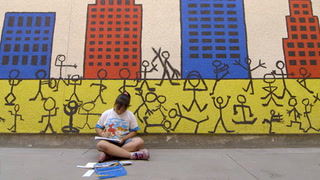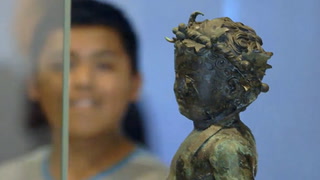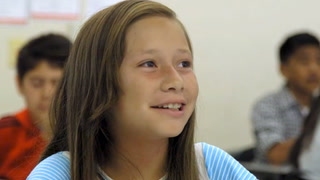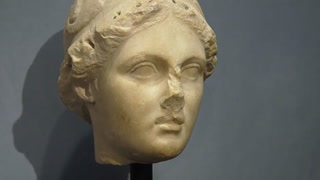See-Wonder-Think Transcript
DAVID COOPER [sync]
00:00:02 What are the three steps we use when we interpret art?
JASON
00:00:05 Three steps we use to interpret art were See, Wonder, and Think.
00:00:10 [TITLE: See – Wonder – Think]
[TITLE: A Classroom Strategy]
DAVID COOPER
00:00:13 See, Wonder, Think. It’s a strategy to observe art. We want them to look at something closely and create a thoughtful interpretation of what they’re looking at. To begin the See, Wonder, Think technique I tell the students they are going to look at an image for 60 seconds.
00:00:31 [TITLE: STEP 1 – SEE]
[TITLE: Observe closely.]
DAVID COOPER
00:00:35 They have no pencils in their hands. There’s no paper to write on yet. Their only job is to look at the image and try to identify small and big details. Then, I give them a graphic organizer and have them write down three things that they saw.
00:00:54 [TITLE: CLASSROOM STRATEGY]
[TITLE: Graphic organizers help students organize their thoughts for each step.]
DAVID COOPER
00:00:58 The graphic organizer is broken into two sections and each section has three parts to it. In each section they have an opportunity to write down either what they see, the questions that they came up with, and the wonder, or their interpretations in the Think section.
00:01:12 The graphic organizer helps them know where they are at in the three steps. The second step is Wonder.
00:01:18 [TITLE: STEP 2 – WONDER]
[TITLE: What do you wonder about what you see?]
DAVID COOPER
00:01:20 I told students that now they’re supposed to come up with questions about what they saw – allowing them to make inferences, to wonder about things that they can’t see, based on things that they can see.
THRASHER SWEATSHIRT
00:01:31 I wonder if that is the original color of the statue.
DAVID COOPER
00:01:36 The last phase is Think and this gives these students an opportunity to make interpretations.
00:01:41 [TITLE: STEP 3 – THINK]
[TITLE: What can you infer about your observations?]
DAVID COOPER [sync]
00:01:43 What else do you see in this image, Table One, that might indicate what this is a goddess of?
DAVID COOPER
00:01:49 They take the questions that they came up with during the Wonder section and they look for visual evidence to try to answer their own questions.
FACE PAINT
00:01:57 She’s holding something in her left hand.
DAVID COOPER [sync]
Can you tell what that object is?
DAVID COOPER
00:02:02 Sometimes they’re going to be able to come up with a possible answer to their question and sometimes they’re not going to be able to find any visual evidence. Both outcomes are okay. Part of the job of See, Wonder, Think is to teach the students there are often times when we make interpretations about art that we don’t have any way to immediately answer.
00:02:19 Often, it requires further investigation.
DAVID COOPER [sync]
00:02:22 It looks like Aphrodite. Very good.
00:02:27 [TITLE: See – Wonder – Think is adapted from the Visible Thinking Routines developed by Harvard University’s research group PROJECT ZERO.]
00:02:36 ***FILE END***
















11 Comments
Tina Tran Nov 22, 2017 12:45am
lori setliff Oct 23, 2016 9:28pm
Rabiah George Oct 12, 2016 3:56pm
Adam Hopson Sep 13, 2016 9:07am
Olivia Uribe Mar 2, 2016 6:06pm